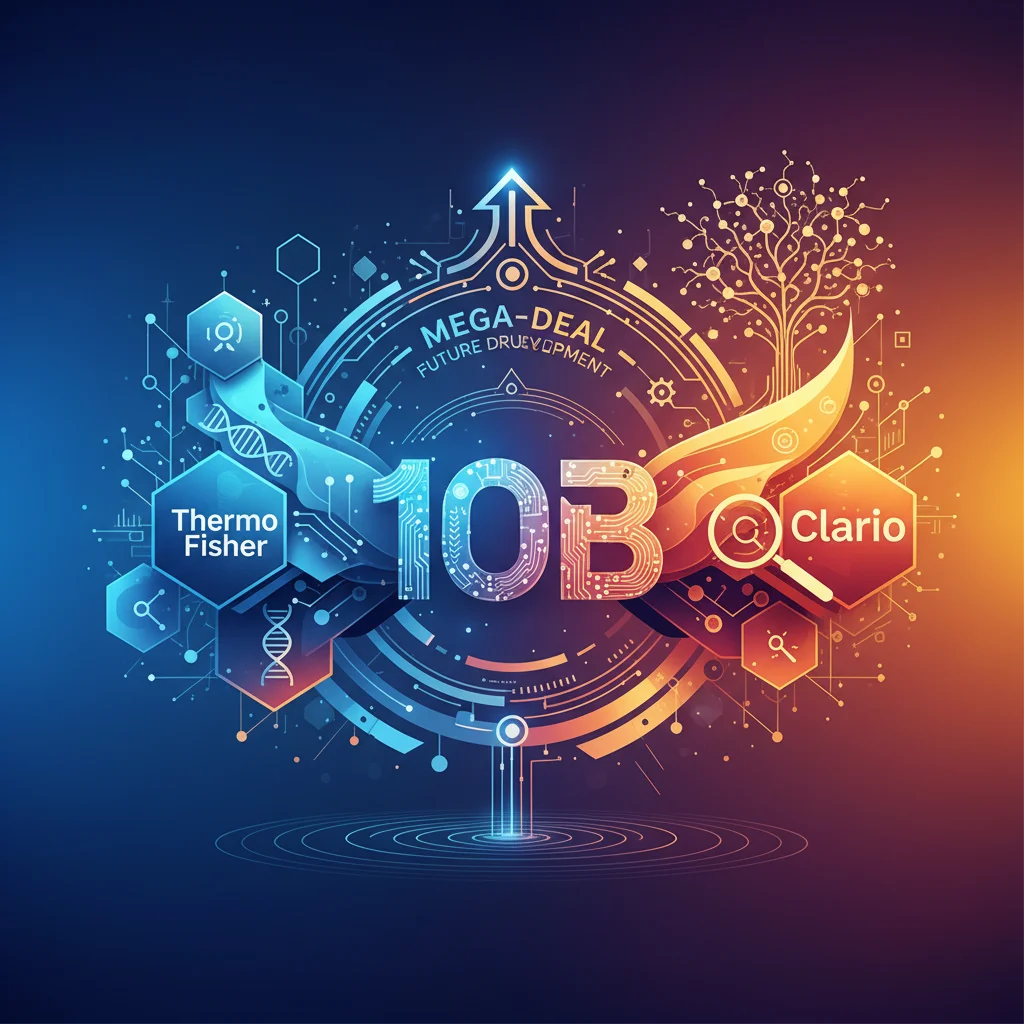
Thermo Fisher’s $10 Billion Bet: Unpacking the Mega-Deal for Clario and the Future of Drug Development
In the high-stakes world of corporate finance and life sciences, billion-dollar deals are the chess moves that redefine industries. A new blockbuster move is reportedly on the board: scientific instrument behemoth Thermo Fisher Scientific is in advanced talks to acquire Clario, a clinical trial software maker, for a staggering sum close to $10 billion. According to a report from the Financial Times, this acquisition would not only reshape the landscape of drug development but also mark one of the most significant private equity exits of the year.
This isn’t just another headline in the business section. It’s a profound statement about the convergence of healthcare, data, and financial technology. For investors, finance professionals, and business leaders, understanding the layers of this deal is crucial. It reveals powerful undercurrents in the global economy, the evolving strategy of life sciences giants, and the immense value now placed on the data that powers modern medicine. Let’s dissect this potential acquisition and explore why it matters so much.
The Players on the Board: A Trio of Titans
To grasp the full weight of this transaction, we must first understand the key entities involved. This isn’t a simple buyout; it’s a strategic alignment of a publicly traded giant, a specialized technology leader, and a major private equity powerhouse.
Thermo Fisher Scientific (NYSE: TMO): The Consolidator
With a market capitalization hovering around $225 billion, Thermo Fisher is a dominant force in the life sciences sector. It’s often described as the “Amazon of the lab,” providing everything from analytical instruments and lab equipment to software and services for research, analysis, discovery, and diagnostics. The company’s growth strategy has been heavily fueled by strategic acquisitions, integrating new capabilities to create a comprehensive, end-to-end ecosystem for its customers in the pharmaceutical and biotech industries. This aggressive approach to investing in its portfolio has made it a bellwether for the health of the scientific and medical research economy.
Clario: The Digital Backbone of Clinical Trials
Clario is not a household name, but in the world of drug development, it’s a critical player. The company specializes in software and technology solutions that manage the complex logistics and data collection of clinical trials. From patient-reported outcomes captured on a smartphone to medical imaging analysis, Clario provides the digital infrastructure that ensures trial data is accurate, secure, and compliant. In an era where the efficiency and success of drug trials are paramount, Clario’s financial technology (fintech) solutions for the medical world are indispensable.
Nordic Capital: The Private Equity Architect
The seller in this deal is Nordic Capital, a leading European private equity firm. They formed Clario in 2021 by merging two existing companies they owned, ERT and Bioclinica. This move was a classic private equity play: combine complementary assets, streamline operations, invest in growth, and create a more valuable, integrated entity. A $10 billion sale would represent a monumental return on their investment, showcasing the power of private equity to reshape and scale businesses before reintroducing them to the market. For the banking and finance community, this exit is a major data point on the health of the M&A market.
Here’s a quick overview of the key players:
| Entity | Role in the Deal | Core Business | Strategic Significance |
|---|---|---|---|
| Thermo Fisher Scientific | Acquirer | Life sciences equipment, services, and software | Expanding its end-to-end drug development ecosystem |
| Clario | Target | Clinical trial management software and data solutions | Provides critical data infrastructure for modern medicine |
| Nordic Capital | Seller | Private equity firm | Executing a highly successful investment exit |
Sequoia's Crossroads: When Free Speech, Corporate Culture, and High-Stakes Finance Collide
The Strategic Rationale: Why Pay $10 Billion for Software?
A price tag of nearly $10 billion demands a compelling strategic justification. For Thermo Fisher, the acquisition of Clario is about much more than just buying a software company; it’s about capturing a crucial, high-growth segment of the pharmaceutical value chain and deepening its integration with clients.
1. Building on the PPD Foundation
This move is a logical extension of Thermo Fisher’s landmark acquisition of PPD, a leading contract research organization (CRO), for $17.4 billion in 2021. PPD manages clinical trials on behalf of pharmaceutical companies. By acquiring Clario, Thermo Fisher would own not only the organization running the trials (PPD) but also the core software platform that collects and manages the trial data. This creates a powerful, vertically integrated service offering that is difficult for competitors to replicate. It transforms the company from a supplier into a deeply embedded strategic partner.
2. The Primacy of Data in Modern Drug Development
The future of medicine is data. The economics of drug development are shifting towards more efficient, decentralized, and data-driven clinical trials. Clario sits at the heart of this trend. Its platforms are essential for gathering high-quality, real-time data, which can accelerate trial timelines, reduce costs, and improve the probability of success. Owning this data layer gives Thermo Fisher immense insight and control, positioning it at the forefront of financial technology innovation within the life sciences.
3. High-Margin, Recurring Revenue
Unlike the one-time sale of a piece of lab equipment, software and data services generate stable, high-margin, recurring revenue. This is highly attractive to a company like Thermo Fisher and is a key reason for its consistently strong performance on the stock market. Integrating Clario’s business model would enhance Thermo Fisher’s financial profile, making it less susceptible to cyclical swings in equipment sales and more aligned with the long-term, predictable nature of software-as-a-service (SaaS) investing.
A Landmark Private Equity Exit in a Tepid M&A Climate
The deal is just as significant from a finance and investing perspective as it is from a strategic one. In a year where high interest rates have put a damper on dealmaking, a $10 billion cash exit is a major event. According to a report from Bain & Company, the private equity industry has been facing a challenging environment for exits, with valuations under pressure and buyers remaining cautious.
Nordic Capital’s ability to command such a high price for Clario demonstrates a few key things:
- Quality Trumps Market Conditions: High-quality, market-leading assets with strong growth and clear strategic value can still attract premium valuations, even in a tough economy.
- The “Buy and Build” Strategy Works: Nordic Capital’s strategy of merging ERT and Bioclinica to create Clario added significant value, proving that thoughtful consolidation can generate outsized returns.
- A Positive Signal for the Market: A successful exit of this magnitude can boost confidence across the M&A landscape, potentially encouraging other companies and private equity firms to move forward with their own transactions. It’s a sign that the gears of high-finance trading and dealmaking are beginning to turn more smoothly.
A Dangerous Double Game? Why the UK's Mixed Signals on China Threaten the Economy
Risks and the Road Ahead
No mega-deal is without its risks. The primary challenge for Thermo Fisher will be the seamless integration of Clario into its vast organization, particularly alongside PPD. Culture clashes, technological hurdles, and ensuring that the promised synergies materialize are all significant operational challenges. Furthermore, regulatory bodies in the U.S. and Europe will undoubtedly scrutinize a transaction that further consolidates power within the life sciences supply chain.
From an investing standpoint, the key risk is valuation. Thermo Fisher will have to demonstrate to the stock market that it can generate enough growth and profit from Clario to justify the hefty price tag. Any stumbles in execution could lead to a negative reaction from shareholders who may feel the company overpaid.
To provide a clearer picture of Thermo Fisher’s acquisition history, here is a look at some of its other major deals:
| Acquired Company | Year | Deal Value (Approx.) | Strategic Focus |
|---|---|---|---|
| PPD, Inc. | 2021 | $17.4 Billion | Contract Research Organization (CRO) Services |
| Life Technologies | 2014 | $13.6 Billion | Genetic Sequencing and Life Sciences Tools |
| Patheon | 2017 | $7.2 Billion | Contract Drug Manufacturing |
| FEI Company | 2016 | $4.2 Billion | High-Performance Electron Microscopy |
The Unseen ROI: Why Civil Disagreement on Campus is a Bull Market for the Economy
Conclusion: A Defining Move for the Decade
Thermo Fisher’s potential acquisition of Clario is far more than a simple transaction. It is a defining statement on the future of the life sciences industry—a future that is digital, data-driven, and deeply integrated. By seeking to control the services that run clinical trials and the software that captures their data, Thermo Fisher is building a formidable moat around its business, positioning itself as the indispensable partner for drug developers for years to come.
For the broader market, this deal is a bellwether. It signals that even in a complex global economy, strategic imperatives and the pursuit of high-quality, tech-enabled assets can drive massive investments. It reaffirms the critical role of financial technology in revolutionizing traditional industries and highlights the immense value that can be unlocked by visionary private equity. As this deal moves towards a final agreement, everyone from stock market traders to banking professionals will be watching closely, recognizing it as a pivotal moment in the ongoing fusion of healthcare, technology, and finance.


